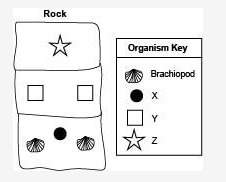
Biology, 27.07.2019 21:00 realpcy7515
Plz ! will fan and like: ) the diagram below shows the layers in a rock having a brachiopod: which statement about the rock fossils is true? organism x existed for a short period of time. organism y became extinct before organism x. organism x and organism y existed at the same time. organism z became extinct much before organism x.


Answers: 2
Another question on Biology

Biology, 21.06.2019 21:10
Zoe decided to measure the hand length of each of her classmates. first she marked a line across each student's wrist and lined up a ruler from this mark to the top of the middle finger to measure the length. then she recorded the measurements in the table below. marla did this the same way for each classmate, and then zoe used this ruler to measure each straight line and record the data below. this data is invalid. what is the most likely reason why it is invalid? the ruler is marked in centimeters, but zoe recorded data in inches. the range of lengths is too wide, so zoe must have misread the ruler. marla’s complicated measuring procedure was overly confusing. marla could have been inconsistent while drawing outlines of fingers.
Answers: 3

Biology, 21.06.2019 22:30
Anita thinks that she has heterozygous alleles for red hair.if she is correct, which of these diagrams best illustrates anitas alleles pf red hair
Answers: 3

Biology, 21.06.2019 23:00
Based on the data in your tables, did the light-colored moths have a higher or lower survival rate after the industrial revolution?
Answers: 2

Biology, 22.06.2019 03:30
Rease is an enzyme used by plants to break down urea (a nitrogen-containing compound) into carbon dioxide and ammonia. urease urea > > > carbon dioxide and ammonia ammonia is broken down by plants into a nitrogen source plants need to grow. thus, plants could not use urea as a nitrogen source unless it was first converted to ammonia. in soybean plants there are two different kinds of urease, one produced in the seeds and the other produced in the leaves of the plant. three types of soybean plants were used in a set of experiments: normal soybeans and two mutant strains, one lacking the urease in the seeds only (strain 1) and one lacking urease in the leaves only (strain 2). experiment 1 separate areas in a field were planted with normal, strain 1, and strain 2 soybeans. all types of soybeans appeared to grow, flower, and produce seeds equally well. there were no externally detectable differences among the strains. experiment 2 small pieces of plant leaves of equal weight were obtained from each type of soybean plant and separately placed on media in culture dishes. tissue growing in this way will become an unorganized clump of cells referred to as callus. to provide a controlled nitrogen source, half the tissue samples of each type were placed on media containing urea, and the other half of the samples were placed on media containing ammonia. after 30 days, the weight gain for each of the callus samples was determined. results are shown in the table below.
Answers: 2
You know the right answer?
Plz ! will fan and like: ) the diagram below shows the layers in a rock having a brachiopod: which...
Questions


Social Studies, 16.05.2021 21:00

Chemistry, 16.05.2021 21:00

Mathematics, 16.05.2021 21:10

History, 16.05.2021 21:10

Mathematics, 16.05.2021 21:10


Mathematics, 16.05.2021 21:10


Mathematics, 16.05.2021 21:10



Mathematics, 16.05.2021 21:10

Mathematics, 16.05.2021 21:10

History, 16.05.2021 21:10

Mathematics, 16.05.2021 21:10







